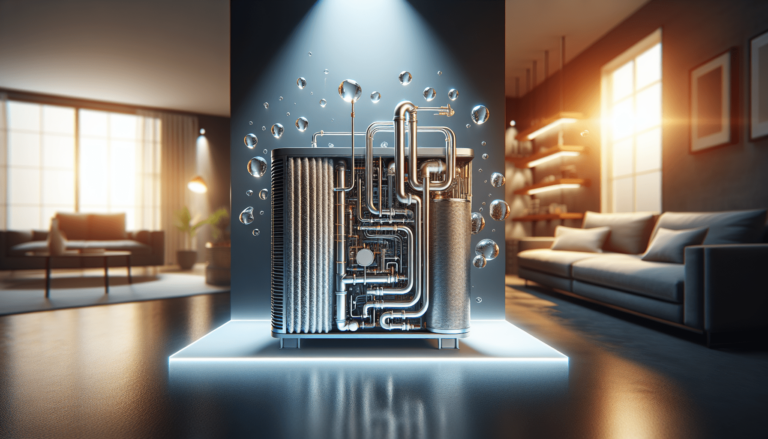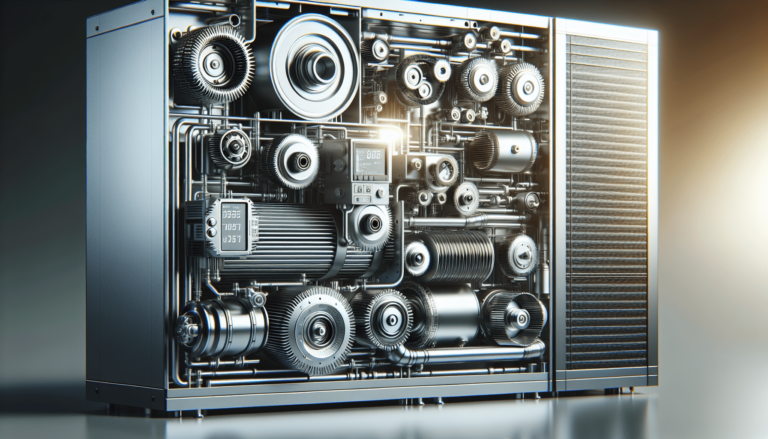

HVAC Services
Get Professional Repairs From The Area's Trusted HVAC Technicians. Ask About Our Services! We Offer Professional Heating & Cooling System Repairs And Guarantee Long-Lasting Results.
Got Question? Call us: (850) 678-2665Financing
Keeping Your HVAC Mold-Free: A Comprehensive Guide
Learn how to keep your HVAC system mold-free with our comprehensive guide. Discover practical tips and expert advice for preventing mold growth and ensuring efficient performance. Protect your home or business and promote a healthy atmosphere.
Maintaining a clean and mold-free HVAC system is essential for a healthy and comfortable living environment. In this comprehensive guide, you will discover practical tips and expert advice on how to keep your HVAC system free from mold. From regular inspections to proper maintenance routines, we will explore effective strategies to prevent mold growth and ensure the efficient performance of your heating and air conditioning system. So, whether you are a homeowner or a business owner, this guide will provide you with valuable insights to protect your HVAC system and promote a mold-free atmosphere.
Understanding Mold in HVAC Systems
Mold is a type of fungus that can grow in various environments, including HVAC systems. It reproduces by releasing spores into the air, which can then settle and thrive in damp areas. HVAC systems provide the perfect conditions for mold growth, as they often have high humidity levels and can accumulate moisture.
How Mold Can Grow in HVAC Systems
There are several factors that contribute to mold growth in HVAC systems. Firstly, if there is a water leak or excessive moisture in the system, mold can begin to grow. HVAC systems also have numerous components, such as air ducts and drain pans, that can accumulate moisture and create a breeding ground for mold. If these components are not properly maintained and cleaned, mold can start to grow and spread throughout the system.
Dangers of Mold in HVAC Systems
Having mold in your HVAC system poses several risks to both your health and the functionality of the system. Mold releases spores into the air, which can cause respiratory issues and trigger allergies or asthma symptoms in individuals who are sensitive to mold. Additionally, mold can compromise the efficiency of your HVAC system by obstructing airflow and reducing its capability to effectively heat or cool your home. It is crucial to address mold in HVAC systems promptly to avoid these potential risks.
Signs of Mold in Your HVAC System
It is important to be aware of the signs that indicate the presence of mold in your HVAC system. While some signs may be more obvious than others, any indication of mold should be taken seriously and addressed promptly to prevent further growth and potential health issues. Here are some common signs of mold in HVAC systems:
Visible Mold Growth
One of the clearest signs of mold in your HVAC system is the presence of visible mold growth. Mold can appear as black or green spots, patches, or even a fuzzy texture on the various components of your system.
Musty or Unpleasant Odors
Another indicator of mold in your HVAC system is the presence of musty or unpleasant odors. These odors may be most noticeable when your HVAC system is running, as it can distribute the smell throughout your home.
Allergy Symptoms
If you or your family members experience allergy-like symptoms, such as sneezing, coughing, or itchy eyes, that seem to worsen when your HVAC system is in use, it may be a sign of mold in the system. Mold spores can trigger allergic reactions in sensitive individuals.
Increased Humidity in the Home
If you notice that the humidity levels in your home have increased significantly, it could be an indication that there is mold in your HVAC system. Mold thrives in humid environments, so an increase in humidity may suggest that there is excess moisture and mold growth in the system.
Preventing Mold Growth in Your HVAC System
Prevention is key when it comes to mold growth in HVAC systems. By implementing the following measures, you can significantly reduce the likelihood of mold taking hold in your system:
Regular Maintenance and Inspections
Performing regular maintenance and inspections on your HVAC system is crucial for preventing mold growth. This includes cleaning or replacing filters, checking for water leaks, and ensuring that all components are in good working order.
Proper Ventilation
Proper ventilation is essential for maintaining a healthy indoor environment and preventing mold growth. Ensure that your HVAC system is properly ventilated, and consider installing exhaust fans in high-moisture areas like bathrooms and kitchens.
Controlling Indoor Humidity
Keeping indoor humidity levels below 50% helps to prevent mold growth. Consider using dehumidifiers in areas with high humidity, and use exhaust fans or open windows to improve airflow and reduce moisture in the home.
Air Purifiers and Filters
Investing in high-quality air purifiers and filters can help to remove mold spores from the air and prevent them from circulating throughout your home. Make sure to regularly clean or replace these filters as recommended by the manufacturer.
Ensuring Proper Drainage
Proper drainage is important to prevent excess moisture buildup in your HVAC system. regularly inspect and clean drain pans, condensate lines, and other drainage components to ensure that they are functioning properly and not contributing to mold growth.
Cleaning and Removing Mold in Your HVAC System
If you discover mold in your HVAC system, it is crucial to address it promptly and effectively. Mold removal can be a complex process, and it is recommended to follow these steps:
Safety Precautions
Before attempting to clean or remove mold from your HVAC system, it is important to take safety precautions. This includes wearing protective equipment such as gloves, goggles, and a mask to prevent inhalation of mold spores.
Hiring a Professional
In many cases, it is best to hire a professional mold remediation specialist to handle the cleaning and removal of mold in your HVAC system. They have the expertise and specialized equipment to safely and effectively eliminate mold.
DIY Cleaning Methods
If you choose to clean the mold yourself, ensure that you follow proper procedures to minimize the risk of spreading mold spores. Use a mild detergent and water solution to clean affected surfaces, scrubbing gently to remove visible mold.
Using Mold-Specific Products
There are also mold-specific cleaning products available on the market that can help to remove mold from your HVAC system. These products are specifically designed to eliminate mold and prevent its regrowth.
Preventing Future Mold Growth
After cleaning the mold from your HVAC system, it is important to take steps to prevent its recurrence. Implement preventive measures such as regular maintenance, proper ventilation, and controlling indoor humidity to reduce the likelihood of mold growth.
Maintaining Air Ducts to Prevent Mold
Air ducts are a common area for mold growth in HVAC systems. Regular maintenance and cleaning of air ducts are crucial for preventing mold. Consider the following measures to maintain your air ducts:
Understanding Air Ducts
Air ducts are responsible for distributing conditioned air throughout your home from your HVAC system. They are typically made of metal or fiberglass and can accumulate dust, debris, and moisture, creating an environment conducive to mold growth.
Regular Duct Cleaning
Regularly cleaning your air ducts is essential for preventing mold growth. Hire a professional to thoroughly clean your air ducts, removing any accumulated dust, debris, or mold.
Sealing Air Leaks
Air leaks in your air ducts can allow moisture to enter and contribute to mold growth. Regularly inspect your air ducts for any leaks and promptly seal them to prevent moisture infiltration.
Insulating Air Ducts
Insulating your air ducts can help to prevent condensation and reduce the risk of mold growth. Insulation helps to maintain consistent temperatures and minimize moisture accumulation.
Monitoring Air Quality
Regularly monitoring the air quality in your home can help to identify any issues or potential mold growth in your HVAC system. Consider using an air quality monitor to keep track of humidity levels, allergens, and potential mold spore concentrations.
Preventing Mold in Air Conditioning Units
Air conditioning units can also be vulnerable to mold growth if not properly maintained. To prevent mold in your AC unit, consider the following steps:
Cleaning and Maintaining Condensate Drains
Condensate drains in your AC unit can become clogged with debris, allowing moisture to accumulate and potentially lead to mold growth. Regularly clean and maintain these drains to prevent blockages and ensure proper drainage.
Inspecting and Cleaning Evaporator Coils
Evaporator coils in your AC unit can also accumulate dirt and debris, creating a favorable environment for mold growth. Regularly inspect and clean these coils to prevent mold and ensure the efficient operation of your AC unit.
Using UV Lights for Mold Prevention
UV lights can be installed in your AC unit to help prevent mold growth. These lights effectively kill mold spores and bacteria, reducing the risk of mold spreading throughout the system.
Replacing Air Filters Regularly
Air filters in your AC unit play a crucial role in maintaining clean air and preventing mold. Regularly replace these filters as recommended by the manufacturer to ensure proper airflow and filtration.
Properly Sizing and Installing AC Units
Properly sizing and installing AC units is crucial for preventing moisture buildup and mold growth. A unit that is too large for your space may not adequately dehumidify the air, leading to excess moisture and potential mold growth.
Dealing with Mold on HVAC Insulation
Mold growth on HVAC insulation can compromise the effectiveness of your insulation and contribute to the spread of mold spores. Consider the following steps to address mold on HVAC insulation:
Identifying Mold on Insulation
Inspect your HVAC insulation for any signs of mold growth. Mold on insulation can appear as discolored spots, black patches, or a fuzzy texture.
Removing Mold from Insulation
If you identify mold on your HVAC insulation, it is best to consult a professional mold remediation specialist. They have the expertise and proper equipment to safely remove mold from insulation.
Replacing Insulation
In some cases, mold growth may have compromised the integrity of your insulation, requiring replacement. Consult a professional to assess the extent of the damage and determine if insulation replacement is necessary.
Preventing Mold Regrowth
After addressing mold on HVAC insulation, it is important to implement preventive measures to prevent its regrowth. This includes maintaining proper humidity levels, controlling moisture, and regularly inspecting and cleaning your HVAC system.
Addressing Mold in HVAC Components
Mold can also affect various components of your HVAC system. Proper cleaning and disinfection are necessary to prevent the spread of mold spores throughout your home. Consider the following steps to address mold in different HVAC components:
Mold in Air Handlers
Air handlers can collect moisture and debris, creating an ideal environment for mold growth. Consult a professional to thoroughly clean and disinfect air handlers, ensuring the removal of any mold.
Mold in Ductwork
Ductwork can become a breeding ground for mold if not properly maintained. Hire a professional to inspect and clean your ductwork, removing any mold and ensuring the proper functioning of your HVAC system.
Mold in Vents and Grilles
Vents and grilles can accumulate dust, debris, and mold spores, which can then be circulated throughout your home. Regularly clean and disinfect these components to prevent the spread of mold.
Mold in Registers and Diffusers
Registers and diffusers are vulnerable to mold growth due to their proximity to moist air. Clean and disinfect these components regularly to prevent mold accumulation and ensure clean airflow.
Cleaning and Disinfecting Components
When addressing mold in HVAC components, it is important to follow proper cleaning and disinfection procedures. Use mold-specific cleaning products and consult a professional if needed to ensure the thorough removal of mold.
Tips for Preventing Mold in Your Home
In addition to maintaining your HVAC system, there are several general tips you can implement to prevent mold growth in your home:
Maintaining Proper Indoor Humidity
Maintaining indoor humidity levels below 50% is crucial for preventing mold growth. Use dehumidifiers in areas with high humidity, and consider opening windows or using exhaust fans to improve airflow and reduce moisture.
Properly Sizing HVAC Units
Properly sizing your HVAC units ensures that they can effectively dehumidify the air and prevent moisture buildup. Consult a professional to determine the appropriate size for your space.
Using Dehumidifiers
In areas with high humidity, using dehumidifiers can help to reduce moisture levels and inhibit mold growth. Place dehumidifiers in basements, bathrooms, or other areas prone to excess humidity.
Keeping Your Home Clean and Dry
Regularly clean and dry your home to prevent mold growth. Remove any visible mold promptly, clean up water spills or leaks immediately, and ensure good ventilation throughout your home.
Promptly Addressing Water Leaks
Water leaks should be addressed promptly to prevent moisture accumulation and mold growth. Regularly inspect your home for any leaks and promptly repair them to prevent further damage and the potential for mold.
Conclusion
Mold growth in HVAC systems can present significant risks to both your health and the functionality of your system. By understanding the signs of mold, implementing preventive measures, and addressing mold promptly and effectively, you can keep your HVAC system mold-free and ensure a healthy indoor environment for you and your family. Regular maintenance, proper ventilation, controlling indoor humidity, and professional assistance when needed are key to preventing mold growth and maintaining a safe and efficient HVAC system in your home.







